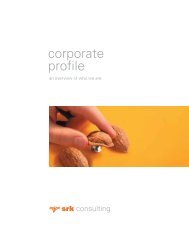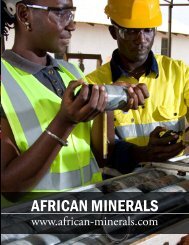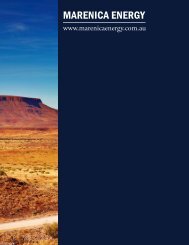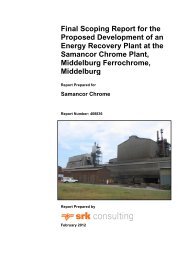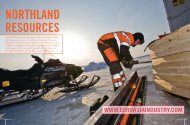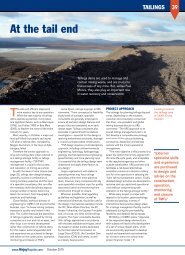Draft Status Quo Report for the Pixley Ka Seme ... - SRK Consulting
Draft Status Quo Report for the Pixley Ka Seme ... - SRK Consulting
Draft Status Quo Report for the Pixley Ka Seme ... - SRK Consulting
Create successful ePaper yourself
Turn your PDF publications into a flip-book with our unique Google optimized e-Paper software.
<strong>SRK</strong> <strong>Consulting</strong> in association with BKS<br />
<strong>Pixley</strong> <strong>Ka</strong> <strong>Seme</strong> Local Municipality EMF – <strong>Draft</strong> <strong>Status</strong> <strong>Quo</strong> <strong>Report</strong> Page 55<br />
Asset Opportunity Constraint / Threat<br />
<strong>the</strong> PKSLM and <strong>the</strong> downstream<br />
context<br />
• Opportunity <strong>for</strong> curriculum-based<br />
education programme to ‘piggy-back’<br />
on existing initiatives<br />
• A high profile project which can be<br />
carried out in collaboration with<br />
national, provincial and local<br />
government, funders and o<strong>the</strong>r key<br />
role-players (such as water boards).<br />
Source: Adapted from <strong>SRK</strong> (2010) and Van Niekerk et al. (2010)<br />
Table 4-2: Assets, opportunities and constraints/threats associated with aquatic and wetland<br />
ecology<br />
Asset Opportunity Constraint / Threat<br />
Abundant supply of water<br />
Strategic location<br />
Unique aquatic habitats<br />
Pristine state<br />
Threatened species<br />
Sensitive fish<br />
Relevant ecological<br />
programmes<br />
Source: Palmer (2010)<br />
The study area is located within an area of<br />
high rainfall that is provided at a<br />
comparatively high level of assurance.<br />
The area is strategically important because<br />
of its location in <strong>the</strong> upper reaches of three<br />
primary catchments.<br />
The study area is characterised by an<br />
abundance of floodplains and unchannelled<br />
valley bottom wetlands, providing ideal<br />
habitat <strong>for</strong> high biodiversity, particularly <strong>for</strong><br />
bird species.<br />
The area is currently in comparatively good<br />
ecological condition. This is attributed to a<br />
combination of high altitudes, low<br />
temperatures and moderate rainfall. The<br />
area thus has a high conservation status as<br />
well as high ecotourism potential.<br />
Key faunal species include red data species<br />
of birds, species of fish and frog that are of<br />
conservation concern. These areas thus<br />
have a high conservation status and<br />
ecotourism potential particularly from bird<br />
watchers hoping to see <strong>the</strong>se rare species.<br />
The presence of a number of sensitive fish<br />
species indicates <strong>the</strong> water quality in that<br />
area is of good quality.<br />
There are a number of programmes in <strong>the</strong><br />
area aimed at enhancing ecological<br />
integrity through, <strong>for</strong> e.g. reducing <strong>the</strong><br />
effects of alien plant species on water<br />
sources (Working <strong>for</strong> Water). This<br />
programme contributes to increased water<br />
availability to a variety of users, as well as<br />
job creation. O<strong>the</strong>rs programmes include<br />
Working <strong>for</strong> Wetlands and Working on Fire.<br />
Water use by agriculture and <strong>for</strong>estry<br />
activities pose a threat to water supply.<br />
Because of <strong>the</strong> area’s strategic location, <strong>the</strong><br />
demands <strong>for</strong> power plant cooling, and<br />
domestic and industrial demands in<br />
Gauteng need to be met putting pressure<br />
on water quality and quantity restricting<br />
activities in <strong>the</strong> area.<br />
Mining license issued <strong>for</strong> an open cast coal<br />
mine near <strong>the</strong> Wakkerstroom wetland<br />
reserve but have since been withdrawn<br />
(April 2010).<br />
Cultivation often converts wetland areas<br />
due to <strong>the</strong> high water supply required.<br />
The ecological condition needs to be<br />
protected through conservation activities<br />
and sustainable development.<br />
The ecosystems in which <strong>the</strong>se species are<br />
found will need to be conserved, which will<br />
restrict agricultural and mining<br />
development.<br />
A number of fish species that are sensitive<br />
to water quality deterioration occur within<br />
<strong>the</strong> area. The survival of <strong>the</strong>se fish species<br />
depends on <strong>the</strong> quality of <strong>the</strong> water in <strong>the</strong><br />
area.<br />
The effectiveness of <strong>the</strong>se programmes can<br />
be constrained due to a lack of capacity and<br />
monitoring.<br />
KILI/BEAT G:\404946_PIXLEY EMF\7REPORTS\<strong>Status</strong> <strong>Quo</strong> report\<strong>Draft</strong> report\<strong>Draft</strong> status quo report, July 2010.docx July 2010



